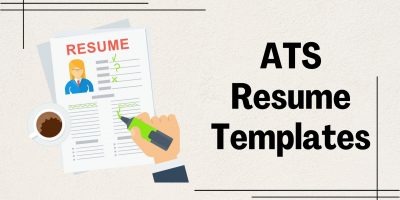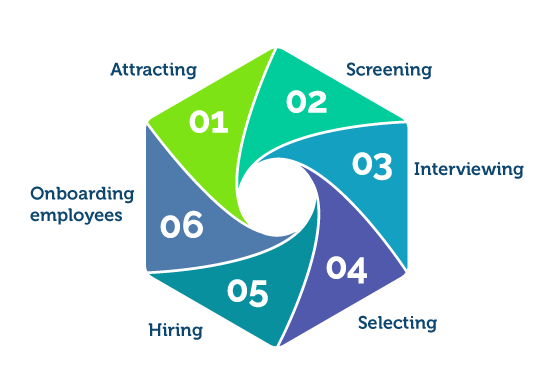
ATS Resume Templates
From remote work integration to cutting-edge recruitment tech, explore the transformative shifts in the staffing industry.

Today’s tight job market means the best candidates are hard to find, hard to attract, and hard to keep. So, to win in the war for talent, organizations need to develop a robust talent acquisition strategy with a candidate-centric mindset.
In other words, hiring quality talent today means organizations must have a carefully mapped-out recruitment process. In this article, we’ll share recruitment tips and steps to follow for a successful recruitment process.
The recruitment process often called the hiring process, involves all the steps in finding and selecting the best candidate to fill an open position in an organization. It includes everything from identifying an available role to attracting, screening, interviewing, selecting, hiring, and onboarding employees.
While the exact process looks different in every organization, the goal is the same – hiring and retaining top talent.
The recruiting process is a core function of the Human Resource department and can be carried out by managers, recruiters, talent acquisition specialists, Human Resource Management (HRM), or a combination of all.
Many organizations use recruiting software to make the hiring process more streamlined and efficient. In addition, some companies outsource this function to recruiting firms, while others choose to carry out this process in-house.

When it comes to recruiting, an ideal process allows companies to find highly-qualified candidates quickly and efficiently. This means the process requires constant reengineering, evaluation, and deliberate planning.
Unsurprisingly, leading organizations use talent management as a business strategy. The recruiting process of high-performing companies is shaped by the shifts in the workforce landscape and their internal needs.
For example, persisting labor shortages indicate that traditional talent pools are less viable for sourcing candidates, so organizations must use different methods to tap into unconventional talent pools.
Aside from reforming outdated recruiting practices, this process should be streamlined and automated. Each member must be equipped with the tools and resources required to do their job efficiently. Additionally, a step-by-step approach that follows different phases to select a suitable candidate will give structure and maximize efficiency.
The average time to hire for an open position is 36 days.
For that reason, the recruitment process is one of the most time-consuming, and when it’s not done right, it can lead to wasted time, money, and energy. However, companies can systemize the recruitment process by designing a proper flowchart.
A recruitment process flowchart is a visual layout of the hiring plan and maps out the whole process, thus simplifying things for the recruiter and the candidate. A well-designed flowchart keeps the hiring process transparent, consistent, and fairer.
Visualizing the process better and knowing which steps to anticipate makes it easy for recruiters to filter out the best candidates. Overall, it ensures smooth handling of the recruitment process for all parties.
This tool can go from being a simple, hand-drawn diagram to a complex, computer-designed chart with various processes. To build an ideal flowchart, an organization must break down this process into actionable and simple recruitment process steps.

A step-by-step recruitment process manual helps guide companies through this process. Depending on the role, company structure, and industry, the steps may vary; however, typically, the hiring process consists of:
As the first step of the hiring process, HR and other decision-makers must clearly identify a need to hire. Whether replacing an employee who left the organization or creating a new position, the hiring process begins once a long-term or short-term hiring need is established. For example, if you want to customize your Salesforce environment to fit your specific needs, you’ll need to hire a trained Salesforce expert.
Once a need to bring in a new hire is established, the next step is determining the job specification and criteria. A job description includes:
By preparing a comprehensive job description with clearly defined responsibilities, potential applicants will know what they need to have to meet the role’s demands.
A company can choose to conduct recruitment from:
To move on to the following stages, reviewing, evaluating, and screening applicants and their cover letters, CVs, and other documents are crucial to finding top-tier employees. The use of technology and software such as Applicant Tracking Systems (ATS) can streamline this process and make it faster.
Job interviews require careful planning and preparation. The first step in this stage is creating a list of standardized interview questions. Next is deciding what the interview process will be like, how many interviews the candidate will need to go through, and how and by whom they will be conducted. Companies can do phone interviews, video interviews, or traditional in-person interviews.
After meeting a number of interviewees and potential candidates, it is time to choose a candidate that is the best fit for the role and company culture. Before moving on to the next step, ensure that the candidate’s credentials and references are checked.
Once a candidate is selected, the hiring team makes an offer letter. This stage may involve salary and benefits negotiations and back-and-forth discussions, but it ends when the candidate signs the extended offer.
Onboarding is a crucial step in employee retention as it aims to integrate the newcomer with the coworkers, company culture, policies, and more. A carefully designed positive employee experience increases the loyalty of new hires and decreases absenteeism and ramp-up time.
Employees are an organization’s most valuable resource.
Hiring someone that doesn’t fit the bill can be damaging in many ways. As mentioned in “The Cost of a Bad Hire” article, the consequences of a single bad hire can cause a ripple effect with lasting harmful effects.
In fact, the average cost of a single bad hire is almost $15,000.
Undoubtedly, a poor recruitment strategy costs money and time.
On the other hand, effective recruitment can help a company achieve faster and greater levels of growth. Well-organized recruitment processes deliver top quality, more engaged hires, providing a competitive advantage that directly impacts business performance.
Thus, the recruitment and selection process is one of the most critical HR functions and vital to long-term organizational growth. Investing time in designing and implementing an effective recruitment process produces many benefits.

The recruitment process is anything but simple. However, HR professionals can follow specific steps and create a structured flowchart guaranteeing success and gaining a significant competitive advantage.
Browse our curated list of vendors to find the best solution for your needs.
Subscribe to our newsletter for the latest trends, expert tips, and workplace insights!

From remote work integration to cutting-edge recruitment tech, explore the transformative shifts in the staffing industry.

What once was considered unconventional work has become mainstream and possibly the future of work. Does the gig economy offer something that traditional employment doesn’t?
Explore the functionalities of applicant tracking systems (ATS) with our detailed guide, uncovering the tools and features that streamline your recruitment process.

As top talent is becoming more scarce, is hiring from within becoming a critical business objective for growth?
Used by most of the top employee benefits consultants in the US, Shortlister is where you can find, research and select HR and benefits vendors for your clients.
Shortlister helps you reach your ideal prospects. Claim your free account to control your message and receive employer, consultant and health plan leads.